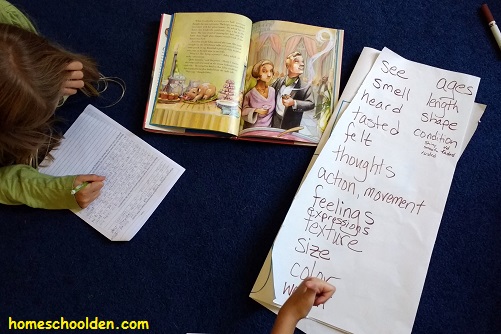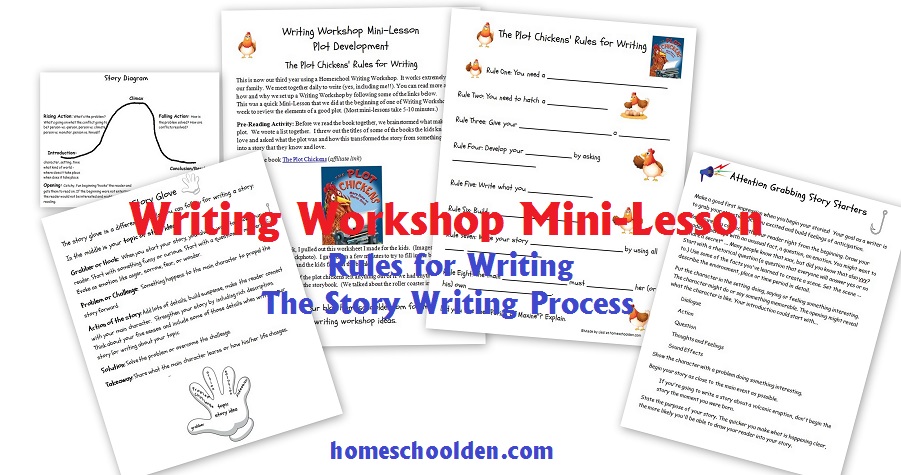Writing: Show Don’t Tell Practice Worksheets (Free Packet)
Today I have some writing practice pages to share with you about the concept, “Show Don’t Tell.” The kids and I are spending a number of days talking about this writing strategy.
“Show Don’t Tell” helps the reader to experience the story by using descriptions, actions, thoughts, feelings, & emotions.
Using this technique helps readers feel like they are right in the middle of the action!
Here’s how I explained it to the kids:
Some sentences are downright boring.
- She was happy.
- He went to the store.
- It was a good day.
You can provide much more detail to help the reader imagine what is happening. Imagine the specific details of the scene so the reader can almost visualize, hear, smell and feel that world. You want the reader to feel as if they are right there, experiencing the story with the descriptions, actions, thoughts and feelings.
The first day, the kids went on to what a person looks like when they have certain feelings (such as anger). Then they had to describe a couple of well-known characters in detail.
Then the second day, we brainstormed about the kinds of details that help people form mental images in their minds. We came up with a long list – and the kids jotted those down in their writing packet. I read a passage in Cinder Edna (affiliate link) (a book we’ve read many times before) when Cinderella (and Cinder Edna) enter the ball. Then the kids had to write their own versions.

Another day, we had to set the scene for an encounter with BigFoot providing the details to help the reader envision the scene. With this exercise the kids had to try to build interest and suspense by describing the situation without stating it outright. I wanted them also to highlight how this made the person feel.
DD wrote:
…My breath was heavy as my eyes darted around. Suddenly, a twig snapped behind me! I spun around as I saw a shadow flit in the corner of my eye. I smelled of fear…
This is so much more powerful than just stating the obvious: I saw BigFoot.
At this rate, the writing packet will take us another week or so to go through (because sometimes we’re just doing one of the exercises), but I love the fact that they beg for more! (After doing a mini-lesson exercise the kids go on to write for 20 minutes for our homeschool Writing Workshop.)
Our writing practice exercises for Show Don’t Tell are free to download if you can use them. 🙂 ~Liesl
This packet is 7 pages.
Free Writing Practice Exercises: Show Don’t Tell
We are using these pages in conjunction with our Writing Workshop (more about that below) and with the writing curriculum we are using this year called Cover Story. It’s a middles school curriculum and I am using it this year with my kids who are 8, 11 and 13. (I am not an affiliate, but love the program so far!) The kids are really enjoying the short video lessons (which are about 10-15 minutes in length). They are fun, engaging lessons that really emphasize good writing skills and techniques.
More about the Cover Story Curriculum: So far we have watched about a half-dozen of the video lessons, have chosen our magazine themes, and the kids have started reading the Remarkable Journal (though they are not writing in it because we still do our own writing workshop). My son read the entire Journal and loved it. (My youngest has trouble reading the cursive script used in the Journal.) I am really happy with the program and the kids beg to watch another (video) lesson. (I have three kids and recommend it highly for my older two ages 11 and 13 – grades 6 and 8, but I would have waited with my youngest (8) because I think she would get more out of it later. Maybe she’ll do the program again in a few years. On the other hand, she *loves* the video lessons too and I know she’s getting a lot out of them.) I’ll come back later to write a more thorough review as we go. 🙂

For a couple of years now, we have used a Writing Workshop in our homeschool. This means that we have a designated writing time and set routine each day for working on writing projects. Most of the time our writing time is self-directed… which is much more natural and like real life. The kids work on all kinds of writing projects (of their own volition). They’ve written stories, science fiction, poems, riddles, letters to family and friends, research papers, non-fiction articles, and biographies. They’ve done portfolio projects and historical “letters to the editor.”
There are several things that make our Writing Workshop successful:
- We always gather together for Writing Workshop time.
- We usually have a short mini-lesson. This year we are using Cover Story, so we’ll watch the short video lesson before our writing time.
- I always write with the kids. I feel that this one thing *really* contributes most to the success of our Writing Workshop time. Sometimes I write poems, stories, riddles and sometimes I’m more practical and write blog posts or jot down lists of things I need to get done. But I think that because I am invested, modeling, and sharing my writing, the kids really love our writing workshop time.
- We all have pretty writing journals.
- We have strict rules about how our Writing Workshop runs. We set a timer for 20 minutes (sometimes 30 minutes). There is no talking when we are writing. If you don’t know the spelling, just guess (because Mom is busy writing too). If someone finishes early, they may quietly read a writing book or their literature book.
- Sometimes I have writing assignments for them, sometimes I have writing suggestions, but the kids *always* have the choice to work on their own projects if they are fully engaged in something!
- I have a number of resources — from our Writing Prompt Packet, to writing ideas page, to writing books like Unjournaling and Magic… Spilled Ink. The kids are welcome to pour through those resources if they need to find some inspiration.
- When they are “stuck” I always tell them that is what makes them real writers… They are working hard when they are thinking about what to write and that is part of the writing process!!
- We offer time to share our writing. This isn’t always mandatory. Again, we have set rules for this sharing time: look the person in the eye, hands in your lap, no talking (unless it pertains to what is being read).
- We have a date-stamp to use in our journals.
- I do not correct their writing, but over time as the kids read through their past work they notice (and laugh) at mistakes they used to make.
Generally we have a Writing Mini-Lesson before our silent, 20-minute writing session. In the past, we talked about certain writing techniques or literature techniques. We looked at well-known children’s literature and used those to analyze good writing.
Here are some of our previous posts about Writing Mini-Lessons:
- Last year, for example, we started with Writing Workshop Mini-Lesson: Rules for Writing and the Story Writing Process
Other Mini-Lessons to Use in a Writing Workshop (in any order):
- What makes a good book or story?
- Make your story come alive with details and description.
- Creating Interesting Characters
- Story Openings: Set the mood or feeling of your story
- Gathering story ideas from your own life
- Alliteration and more
- Adding Details Exercise (Don’t miss this one, the kids LOVED this activity!!)
- Writing Workshop: Conflict in Literature (Man vs. Man, Man vs. Self, etc)
- Writing Workshop Discussion Questions
More about our Writing Workshop:
- Creating a Homeschool Writing Workshop – Post #1 — How/Why we needed a change in our writing program
- Creating a Homeschool Writing Workshop – Post #2: Creating a Writing Workshop Area and Materials to Have on Hand
- Creating a Writing Workshop Post #3: This post is about Mini-Lessons during writing time, mentor texts and includes reviews of 8 or 9 writing books that you might find helpful.
What about Grammar and Spelling?
During our writing workshop I do not correct for grammar or spelling. My goal is writing fluency. Often they’ll come across mistakes as they share their writing aloud or go back to their projects the next day
As many of you know, we have separate time during our day for spelling and grammar. Often I’ll make our own grammar worksheets as I see problems in their writing. (That’s why I made the their/they’re/there and its/it’s sheets back a few years ago.)
A few days ago, I put together a new Language Arts Resource Page to share the links to those free resources with you (categorized into Writing Workshop Posts; Writing Mini-Lesson Posts; Spelling Resources; Free Grammar Pages, Language Arts curriculum we use in our homeschool, etc.) Hope you find something useful there! 🙂
See you again soon here or Homeschool Den Facebook page. Don’t forget to Subscribe to our Homeschool Den Newsletter!
Happy Homeschooling (and Terrific Teaching!)! ~Liesl
























































